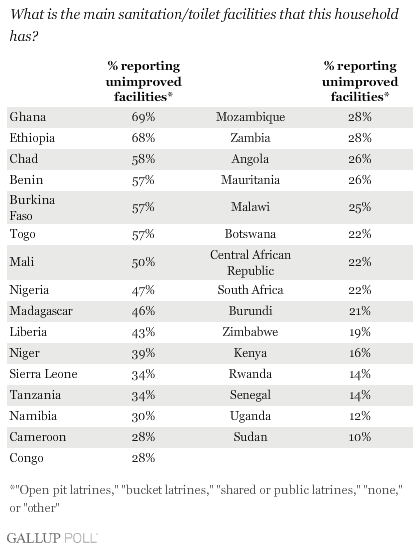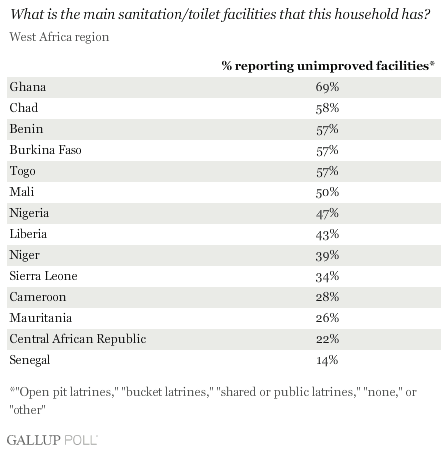The United Nations observed World Water Day Thursday and more around the globe will participate in events on Saturday that draw attention to the billions without access to safe drinking water and basic sanitation. This article, the second in a two-part series, examines sanitation in sub-Saharan Africa.
WASHINGTON, D.C. -- Sanitation is the theme for this year's World Water Day, which focuses on the estimated 2.6 billion people who lack access to basic sanitation. ���۴�ýPolls underscore the extent of the problem in sub-Saharan Africa, where many households rely on unimproved toilet facilities.

Using WHO/UNICEF Joint Monitoring Programme (JMP) distinctions for distinguishing improved and unimproved sanitation, ���۴�ýasked citizens of 31 sub-Saharan African countries about the main sanitation facility in their household. The most common responses were simple pit (22% regional median) and open pit (16% regional median).
Sanitation Situation
���۴�ýPolls reveal that substantial numbers of households throughout the region rely on unimproved toilet facilities that are potentially hazardous to health and the environment. At least half of Malians (50%), Togolese (57%), Burkinabes (57%), Beninese (57%), Chadians (58%), Ethiopians (68%), and Ghanaians (69%) report unimproved sanitation facilities as the main facilities in their households.

Respondents in the West Africa sub-region are the most likely to name an unimproved sanitation facility as their households' main sanitation. The regional median is 45% for West Africa, compared with much lower regional medians of 27% in southern Africa and 16% in East Africa.

Just as sub-Saharan Africa is not on track to meet the Millennium Development Goal target for access to safe drinking water by 2015, neither is it on track to meet benchmarks for access to improved sanitation. The JMP reports that sanitation coverage improved in sub-Saharan Africa between 1990 and 2004, but the number of people without sanitation increased by more than 30%. Sub-Saharan Africa is not expected to meet its sanitation target until 2076.
Survey Methods
Results are based on telephone and face-to-face interviews conducted throughout 2006 and 2007. Randomly selected sample sizes typically number 1,000 residents, aged 15 and older, in the 31 countries polled. In Angola and Congo, surveys were conducted in urban areas. Surveys in Chad and Sudan did not include Darfur. For results based on samples of this size, one can say with 95% confidence that the maximum error attributable to sampling and other random effects is ±5 percentage points. In addition to sampling error, question wording and practical difficulties in conducting surveys can introduce error or bias into the findings of public opinion polls.